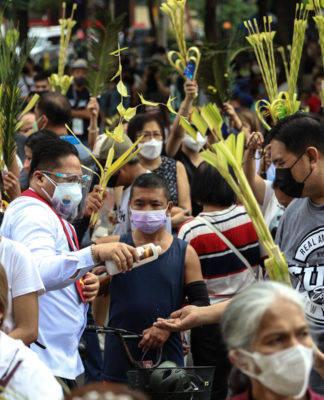 ANGELICA Buenaventura, 18, was no stranger to flooding in UST. She knew it was a given for a campus situated in the heart of Manila’s flood-prone Sampaloc district.
ANGELICA Buenaventura, 18, was no stranger to flooding in UST. She knew it was a given for a campus situated in the heart of Manila’s flood-prone Sampaloc district.
But the flooding that hit the University—and the rest of Metro Manila and neighboring provinces—last September 26 was different.
It trapped an estimated 3,000 people in buildings with limited food on campus for at least 24 hours, in what a University official described as the worst flooding in UST in 40 years.
The situation in UST was far more tempered compared with the chaos outside. Tropical storm “Ondoy” dumped a month’s worth of rainfall in just six hours on Luzon, killing close to 300 people.
“This is indeed the worst,” said Fr. Roberto Pinto, O.P., director of the Facilities Management Office, while wading through knee-deep waters in front of the St. Raymund’s Building. Even the Fathers’ Residence, which does not experience flooding, had ankle-deep flood water, he said.
In St. Raymund’s Building alone, around 300 students, teachers, and employees spent the night on shared meals supplied from the nearby Jollibee outlet on Dapitan Street.
Many of them, like others inside the University, were unable to leave campus even after Rector Fr. Rolando de la Rosa, O.P. suspended classes as early as 9 a.m. on September 26.
Meanwhile, the Central Student Council (CSC) announced around 10 a.m. that college deans had been given the prerogative to suspend classes. Classes in some colleges were not immediately suspended after the announcement.
By that time, floodwaters had already claimed most of the streets surrounding UST.
An official said the Rector was enraged that hundreds of Thomasians were still stranded despite a relatively prompt suspension of classes.
The calamity, which came only a month after monsoon rains had left UST heavily flooded, was a showcase of Thomasian charity.
Students, including UST seminarians, braved strong winds and deep waters to deliver food and supplies to others trapped in buildings like St. Raymund’s Building, Beato Angelico, and St. Martin de Porres Building.
At the UST-Tan Yan Kee Student Center, students hitherto strangers to one another shared newspapers and cardboards and anything that could pass off as blankets for the cold, rainy evening.
With all carpark restaurants closed, trapped people tried to fill their appetite with cup noodles shared by two people each. So were slices of bread made available for breakfast.
“Food was delivered where the students were stranded but we don’t know if it was distributed to everyone,” said CSC public relations officer Margielyn Asilo.
Students cooperated despite the situation, in which everyone had to wait for hours for food.
“They were very patient,” she said. “They were easy to talk to and would tell us nicely if they were hungry.”
Jollibee was only able to deliver 200 meals as supplies did not arrive due to heavy flooding.
The St. Raymund’s and St. Martin de Porres buildings experienced total darkness. Pinto said school officials could not use generators there because the ground levels were heavily flooded.
Despite the inconvenience, people occupying St. Raymund’s refused to transfer to the UST Tan Yan Kee, which had a higher elevation and power supply.
“They (the students) said they would much rather go home than move to [Tan Yan Kee] if they were going to walk through the flood,” said Arts and Letters Student Council Auditor Wayne Uyseco.
Meanwhile, three buses carrying students who were supposed to have their Literacy Training Service in Bulacan arrived at the Student Center around 10 p.m. in the evening after being stranded.
In the following morning when waters had all but subsided, Vice Rector Fr. Pablo Tiong, O.P. drove around campus carrying food items in a red Isuzu D-Max pickup.
Only one store, at the second floor of the carpark, was open to sell breakfast such as hotdogs and longganiza. The stocks were gone before noon.
Mecheline Zonia Manalastas, admissions director, ordered the names of all students inside Tan Yan Kee listed for easier monitoring.
A truck from the Philippine Air Force, as well as UST vehicles, ferried students to the Mabuhay Rotonda and other points where public transport was available.
At the carpark, a group of Engineering students were negotiating with a pedicab driver for a brief but arduous drive around España.
But finding the P50-per-head charge too much, their male classmates offered a piggy-back ride.
A Facebook user said on her page that she was forced to leave her car at the carpark after an official said she could not bring it home without paying P500 for staying overnight. This was even after she had offered to leave her school ID as an assurance that she would return to pay the fee.
Know the manual
A member of the UST crisis management committee admitted that officials were caught off-guard.
Community Development chief Jose Cruz III noted that most faculty members do not have classes during Saturdays.
“The storm [struck] on a Saturday when most administrators, who were also members of the crisis management committee, were not present,” Cruz said.
The University must further disseminate its crisis management manual to lessen the impact of calamities, he said.
The manual lists procedures that should be undertaken in case of natural calamities or disasters.
In 2007, committee procedures stated that students trapped by flood in campus should call the hotline 811. All students and employees must transfer to the Tan Yan Kee Student Center to seek temporary shelter.
Sleeping mats and food were supposed to be distributed to those who need to stay overnight. All gates would be opened beyond 10 p.m. to allow parents to pick up their children.
The crisis management committee is headed by vice rector for Finance Fr. Manuel Roux, O.P. as chairman, with Cristina Castro-Cabral as vice chairwoman. Other members include the CSC, FMO, the UST Health Service, and the security office.

















